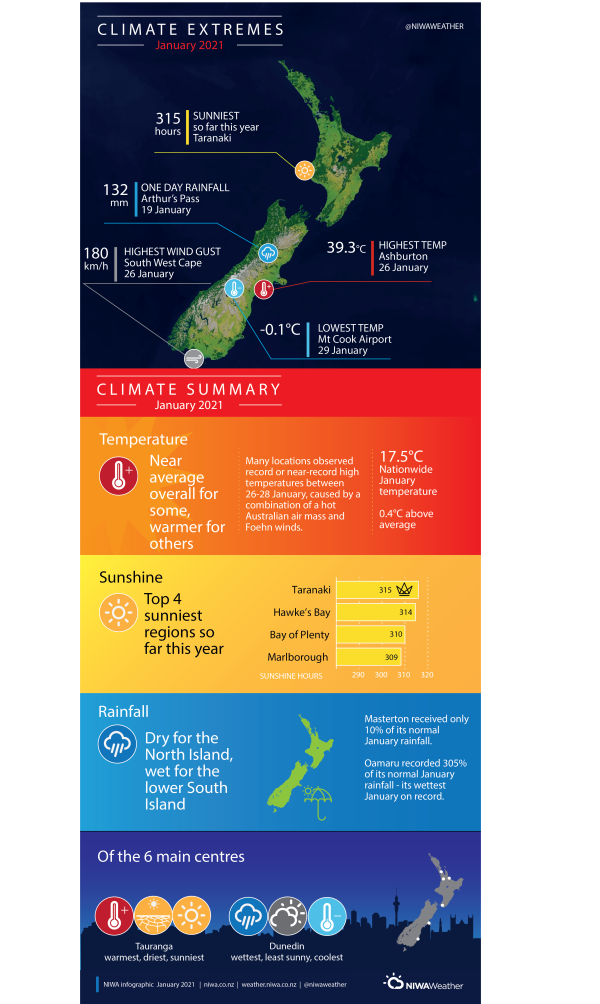A mild month with mixed rainfall patterns.
|
Rainfall |
Below normal rainfall (50-79% of normal) or well below normal rainfall (<50% of normal) was observed in much of Northland, parts of Auckland and Waikato, the Central Plateau, Gisborne south to Wellington, the upper South Island, and coastal central Canterbury. Above normal rainfall (120-149% of normal) or well above normal rainfall (>149% of normal) was observed in much of the lower South Island as well as small portions of interior Canterbury, southern Manawatū-Whanganui, and eastern Bay of Plenty. Near normal rainfall (80-119% of normal) was observed elsewhere. |
|
Temperature |
Temperatures were near average (±0.50°C of average) for much of the South Island and scattered portions of the North Island. However, above average temperatures (>0.50°C above average) were observed in much of the upper and eastern North Island, along with parts of coastal Canterbury. Below average temperatures (<0.50°C below average) were observed in parts of interior Tasman, Canterbury, and Otago. |
|
Soil Moisture |
At the end of January, soil moisture levels were lower than normal for nearly all of the North Island, except Taranaki and coastal Manawatū-Whanganui where soil moisture was near normal. In the South Island, soil moisture levels were lower than normal in Nelson, Marlborough Sounds, northern Tasman, and a small portion of eastern Southland, with higher than normal soil moisture levels from southern Canterbury to Southland. Soil moisture levels were near normal elsewhere. |
Overview
January 2021 mean sea level pressure was lower than normal over and just east of Aotearoa New Zealand. This resulted in more southwesterly winds than normal, keeping temperatures near average in much of the South Island and portions of the North Island, along with cooler than average sea surface temperatures in parts of the Tasman Sea. While moderate La Niña conditions continued in the tropical Pacific, any impacts on weather patterns over New Zealand were not those typically expected.
Rainfall was quite varied across New Zealand during January, with drier than normal conditions found across much of the North Island and upper South Island. Meanwhile, above normal (120-149% of normal) or well above normal rainfall (>149% of normal) was observed in much of the lower South Island, primarily due to a heavy rain event early in the month (see Highlights and extreme events section). Notably, Oamaru and Clyde both experienced their wettest January on record.
Although temperatures for the month as a whole were generally unremarkable, a very warm air mass originating in Australia combined with westerly Foehn winds to produce widespread record and near-record temperatures across eastern New Zealand from 26-28 January. In Ashburton, a blistering 39.3°C was recorded on 26 January. This was New Zealand’s 2nd-hottest January temperature on record, surpassed only by 40.0°C at Timaru on 22 January 1908.
Further highlights:
- The highest temperature was 39.3°C, observed at Ashburton on 26 January. This was followed by 38.9°C at Wakanui, and 38.0°C at Akaroa, both also observed on 26 January.
- The lowest temperature was -0.1°C, observed at Mt Cook Airport on 29 January.
- The highest 1-day rainfall was 132 mm, recorded at Arthurs Pass on 19 January.
- The highest wind gust was 180 km/h, observed at South West Cape on 26 January.
- Of the six main centres in January 2021, Tauranga was the warmest, driest and sunniest, while Dunedin was the coolest, wettest and least sunny.
- Of the available, regularly reporting sunshine observation sites, the sunniest four locations so far in 2021 are Taranaki (315 hours), Hawkes Bay (314 hours), Bay of Plenty (310 hours), and Marlborough (309 hours).
Download
A mild month with mixed rainfall patterns
|
Rainfall |
Below normal rainfall (50-79% of normal) or well below normal rainfall (<50% of normal) was observed in much of Northland, parts of Auckland and Waikato, the Central Plateau, Gisborne south to Wellington, the upper South Island, and coastal central Canterbury. Above normal rainfall (120-149% of normal) or well above normal rainfall (>149% of normal) was observed in much of the lower South Island as well as small portions of interior Canterbury, southern Manawatū-Whanganui, and eastern Bay of Plenty. Near normal rainfall (80-119% of normal) was observed elsewhere. |
|
Temperature |
Temperatures were near average (±0.50°C of average) for much of the South Island and scattered portions of the North Island. However, above average temperatures (>0.50°C above average) were observed in much of the upper and eastern North Island, along with parts of coastal Canterbury. Below average temperatures (<0.50°C below average) were observed in parts of interior Tasman, Canterbury, and Otago. |
|
Soil Moisture |
At the end of January, soil moisture levels were lower than normal for nearly all of the North Island, except Taranaki and coastal Manawatū-Whanganui where soil moisture was near normal. In the South Island, soil moisture levels were lower than normal in Nelson, Marlborough Sounds, northern Tasman, and a small portion of eastern Southland, with higher than normal soil moisture levels from southern Canterbury to Southland. Soil moisture levels were near normal elsewhere. |


